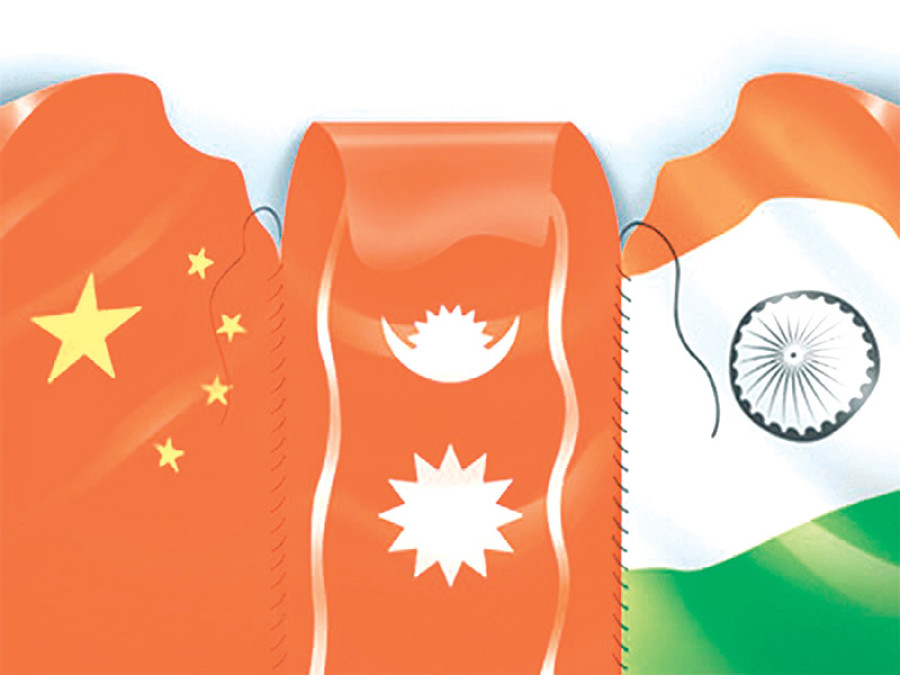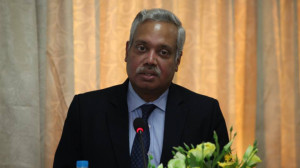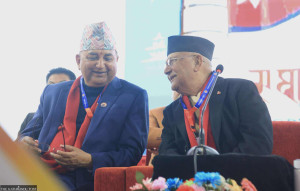National
Trilateral cooperation
Rather than looking for equidistance, Nepal should try and achieve more proximity with both its neighbours
At a time when Nepali politicians are engaged in setting their houses in order, foreign policy is almost a forgotten area. Yet, those with prospects of coming to power appear to be overzealous when it comes to the incoming government that could possibly be led by the CPN-UML leader, KP Oli. Oli, along with his trusted colleagues, visited the Rasuwagadhi entry point on the Nepal-Tibet (China) border and dropped hints that he was keen to continue his mission of developing Nepal-China relations by inviting China for infrastructural development projects agreed upon by the two countries during his tenure as Prime Minister in 2016. This could be seen as an indication of his future foreign policy agenda. India, considered to be a rival power, didn’t exhibit a reaction to Oli’s mention of the Chinese railway project, nor to his much touted expedition to the border. It seems that as of now, India still believes that continuity of traditional relations with Nepal would serve the interests of both.
Due to emerging geo-political developments and given the present world political scenarios that tend to “alter” global trends, Nepal-India-China triangular relations need to be assessed through a new perspective with the purpose of making relations beneficial for all three countries. From a political point of view, India and China are competing powers with regional and global ambitions. How to turn these two powers into mere developmental partners for Nepal is a difficult proposition, but not entirely unachievable. Although it may appear hypothetical, the scope for a trilateral friendship and cooperation can be described under the rubrics of strategic convergence, strategic equilibrium and strategic depth.
A new outlook
Strategic convergence is possible only when there has been a minimum level of understanding in regards to Nepal between the two major players, China and India. Their differences on borders, or in other areas, should not be linked to Nepal, because making Nepal a zone of no competition would contribute to protecting their larger interests, as well as those of Nepal.
To achieve a level of strategic convergence, China and India should undergo major transformations in their policies towards Nepal. The basic ingredients of deep and wide-ranging relations evident in Nepal-India ties should be retained, but the strong security relations that are considered a stigma for national independence and sovereignty should be moderated at the same time. Strategic convergence should be understood as developing trilateral relations in a positive light, so much so that increased Chinese investment and engagement in infrastructural development is not construed by India as a threat to its interests.
Nepal’s physical situation does not allow China and India to make it a playground for cancelling out each other’s influence. The expanding, strategic Chinese linkages with Nepal should not go beyond the boundary that is to be set by the components of strategic convergence. If India tries to be a little bit pragmatic and rational in addressing Nepal’s grievances, the level of misunderstanding can be minimal. The Modi visit in 2014 has proven that Nepalis are not anti-Indian. It is the occasional pinpricks, the inherited Nepali mindset that India has always been overbearing, and India’s complaints that Nepal is trying to promote Chinese interests, that have been perennial sources of misunderstanding. Generally, this is also called big power-small power syndrome as the smaller neighbour always perceives the bigger neighbour to be arrogant, domineering and bullish, while the big powers suspect their smaller neighbours of being permanently resentful or even working to hurt the interests of big powers.
A strategic convergence approach will try to correct psychic and practical cleavages by advancing the idea of cooperative relationships between the three neighbours. Here, big neighbours are expected to understand the aspirations of a country like Nepal. Such aspirations are basically centred on the preservation of national unity, territorial integrity, independence and sovereignty, which are the basic principles of an independent nation state. If certain treaties and arrangements made in the course of historical developments are considered as problematic to these principles, the two neighbours should try to find suitable alternatives so as to fuel cooperative relations. So convergence of strategies should be viewed as a preparation of the background for harmonising emerging geo-political trends and dynamics.
Internal independence
Strategic equilibrium can be attained only when the three countries (China, India and Nepal) share strategic convergence as an understanding of each other’s aspirations based on the agenda of cooperation and friendship. Strategic equilibrium is not taken here as a classical strategic balance as theorised and practiced in the context of international politics. Here, equilibrium formulation means Nepal should be left alone to manage its internal affairs, and in case of internal turmoil or hostile activities, the two neighbours can help with the positive intention of maintaining Nepal as a stable, peaceful country. It means that no country should consider Nepal as being under their sphere of influence. Nepal’s big neighbours are thus expected to be guided by new realities that demand prudence and unconventional approaches to developing trilateral relations.
The strategic depth approach pursues hard options, with the two big neighbours trying to entrench their positions in Nepal and it therefore carries negative connotations in the given context. India’s advantageous position for enhancing strategic depth cannot be ignored but it also has the potential to lead to provocation if the conventional approach of playing off one neighbour against the other is followed. Moreover, if the classical power rivalry game continues unabated, Nepal’s own vital interests would be compromised. So strategic depth would only mean an increase in foreign powers’ activities in Nepal. But it is somewhat gratifying that no such strategic depth is likely to be achieved by rival powers because the very location does not allow them to cross the Rubicon; nor will Nepal be tempted to be a battle ground for its neighbours.
The purpose of this narrative is to impress on Nepal’s two neighbours that a new thinking with a positive attitude needs to be cultivated in order to make sure that their vital interests are not hurt. If the two neighbours show a certain degree of empathy towards Nepal, their developmental efforts would not go in vain as a stable, peaceful and prosperous Nepal would be an asset for them both. In Nepal, the policy of equidistance as expressed by some party leaders and academics is neither plausible nor practicable. On the contrary, a policy of increased proximity to both neighbours should be enhanced. Such proximity should be utilised for Nepal’s development as well as for clearing the clouds of mistrust among the three neighbours.
Baral is a professor and former Nepali ambassador to India




 11.12°C Kathmandu
11.12°C Kathmandu














